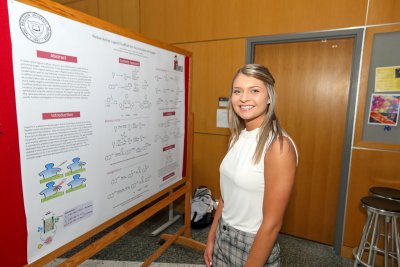SSRP Abstract
Redox-Active Ligand Scaffold for the Activation of Oxygen
 Student: Kaytlin Ward ’21
Student: Kaytlin Ward ’21
Research Mentors: Allen Pistner (OWU Department of Chemistry) and David Lever (OWU Department of Chemistry)
A redox-active ligand scaffold, dipyrrin, was synthesized for applications of activating oxygen. The synthesis of the ligand was modified from previous pathways. The original pathway used a Negishi coupling followed by condensation with an aryl aldehyde using pyrrole and di-tert-butyl phenol. The modified synthesis constructs the ligand with a Suzuki cross-coupling followed by condensation with an aryl aldehyde. A Suzuki coupling allows for the use of more stable reagents and potentially increase efficiency of the synthesis. The modified synthesis also uses naphthol instead of di-tert-butyl phenol to increase conjugation for redox activity. The ligand scaffold was successfully synthesized using the naphthol; however, the Negishi coupling was required. The necessary boronic acid for Suzuki coupling proved difficult to make and purify. Further investigation of the Suzuki coupling is currently underway.
I am continuing research from previous years to find an effective route of synthesizing an organic molecule called a dipyrrin. The molecule can be used in targeted cancer treatment and fuel cells. One of my goals is to create more conjugation within the dipyrrin which will increase the effectiveness for photodynamic therapy, a type of cancer treatment. I also hope to modify the synthesis to avoid air-sensitive reagents and allow for repeatability.
